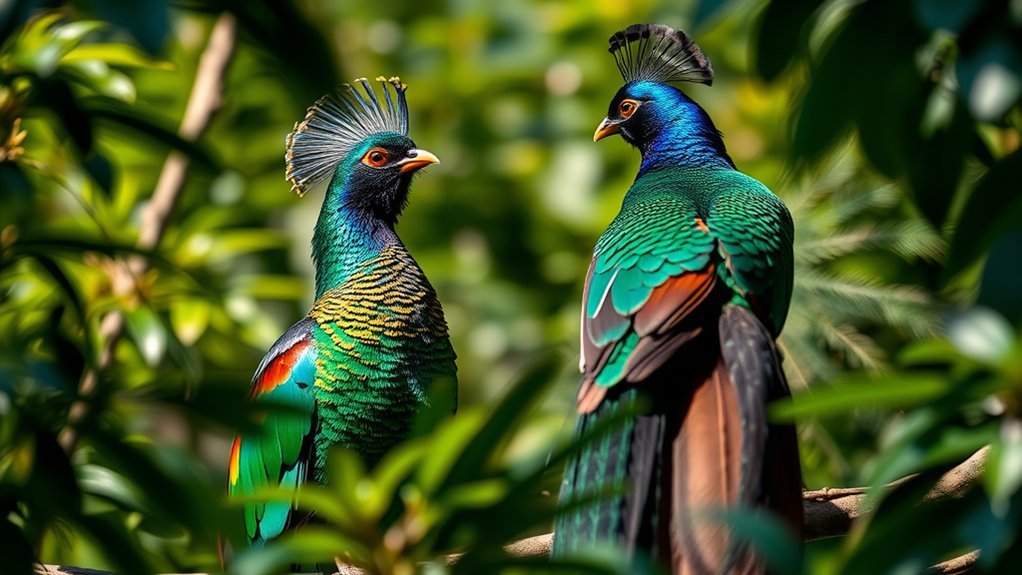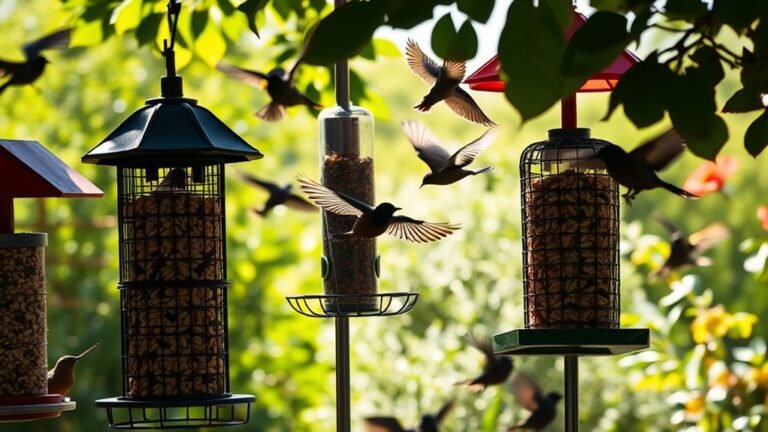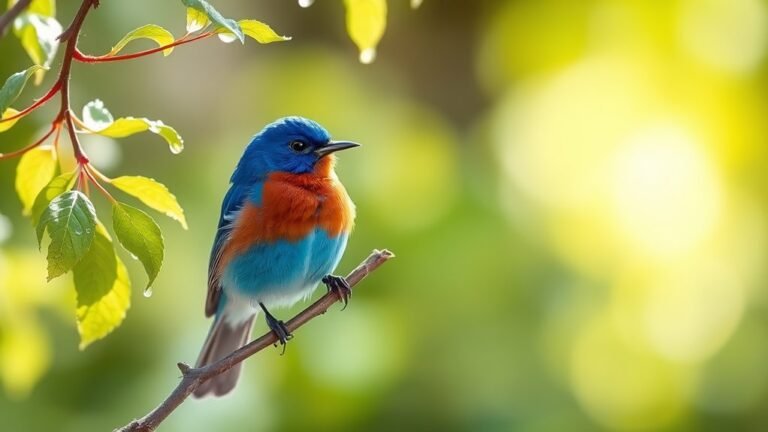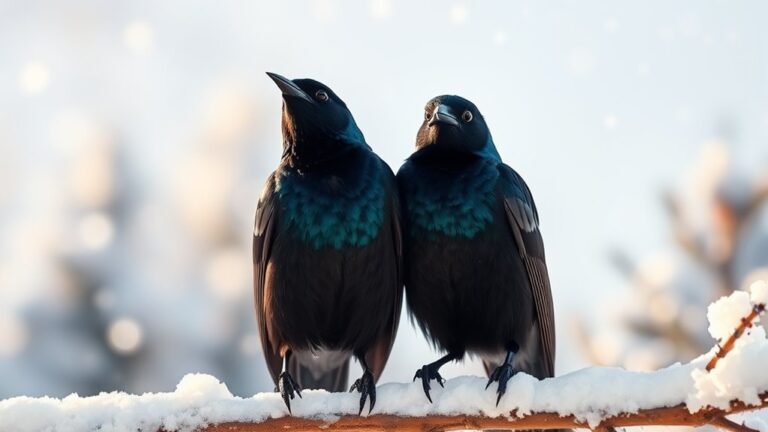Birds Similar to Peacocks: Majestic Alternatives Explored
Birds that are similar to peacocks display impressive beauty and interesting behaviors. The resplendent quetzal has bright, colorful feathers. The Indian argus performs elegant courtship dances. Each bird has unique traits that deserve appreciation. Understanding their characteristics and conservation needs highlights their beauty and importance in our ecosystem. What can these magnificent birds teach us about nature's creativity?
Key Takeaways
- The Resplendent Quetzal features bright colors and long tail feathers. It symbolizes freedom in Mesoamerican cultures.
- Indian Argus males perform a beautiful courtship dance. They show off their colorful feathers and unique eyespots at dawn.
- Mandarin Ducks have striking color patterns. Male ducks use these patterns to attract females during mating season.
- The Victoria Crowned Pigeon is the largest pigeon species. It has deep blue feathers and distinctive markings, and it survives well in the rainforests of New Guinea.
- The Andean Condor has a large wingspan. It plays an important role as a scavenger and represents strength and freedom in mountainous areas.
The Resplendent Quetzal: Nature's Jewel

The resplendent quetzal stands out as one of nature's most striking avian creatures, known for its vibrant plumage and remarkable tail feathers. Native to Central America's highland forests, its quetzal habitat comprises lush cloud forests rich in biodiversity.
These birds thrive in areas where ancient trees provide essential nesting sites.
Culturally, the quetzal holds significant importance in various Mesoamerican societies, symbolizing freedom and wealth; its feathers once adorned the headdresses of nobility.
You'll find that the quetzal not only captivates birdwatchers with its stunning colors but also deepens your connection to the natural world, serving as a beautiful reminder of the intricate relationship between species and their environments.
Understanding its role adds richness to your appreciation of our avian friends.
The Indian Argus: A Dancer of the Forest
With its intricate patterns and intriguing display, the Indian Argus is a remarkable bird that showcases the beauty of the forest floor.
Found mainly in the dense, tropical forests of India, the Indian Argus habitat provides the perfect backdrop for its vibrant plumage and elaborate courtship dance.
During mating season, you'll witness its enchanting behavior; the male fans out its tail, revealing stunning eyespots to attract females. This mesmerizing ritual takes place at dawn, making it a magical experience for anyone lucky enough to observe.
While its camouflage aids in blending into the underbrush, the Indian Argus stands out as a testament to nature's artistry, inviting you to appreciate the complexity of life in the forest.
The Victoria Crowned Pigeon: The Heavyweight of Elegance

Admired for its regal appearance, the Victoria Crowned Pigeon stands out as a true heavyweight of elegance among avian species.
This stunning bird boasts magnificent plumage patterns, with deep blue feathers accentuated by striking white and black markings. As the largest pigeon species in the world, it commands attention with its impressive size and grace. You'll also notice the elaborate crest atop its head, which adds to its distinguished look.
Native to the rainforests of New Guinea, the Victoria Crowned thrives in lush habitats, often found foraging on the forest floor. Promoting conservation of such habitats is key to ensuring this elegant bird continues to flourish.
The Victoria Crowned Pigeon truly embodies the beauty of nature's designs.
The Mandarin Duck: A Vibrant Color Palette
Mandarin ducks showcase an extraordinary vibrancy in their plumage, immediately enchanting anyone fortunate enough to observe them.
With their striking combination of orange, green, and blue feathers, they exhibit one of the most mesmerizing color palettes in the avian world.
These colorful ducks are particularly impressive during the Mandarin mating season, where the males display their vibrant plumage to attract females.
The intricate patterns and vivid hues serve not just for attraction but also for signaling health and importance.
Observing these behaviors provides insight into their social dynamics, revealing a strong connection among individuals.
The Andean Condor: Majestic Wings in the Sky

Although often soaring high above the rugged Andes, the Andean condor captivates observers with its impressive wingspan, reaching up to ten feet. This majestic bird thrives in mountainous habitats, where it glides effortlessly on thermal updrafts.
You'll notice its remarkable Andean condor behavior, which includes social interactions in large groups, often seen perched on rocky cliffs. These scavengers play an essential role in their ecosystem by consuming carrion, thereby maintaining ecological balance.
Their distinct white collar and powerful black feathers create an awe-inspiring silhouette against the sky. Spotting an Andean condor isn't just a visual delight; it's an opportunity to connect with a symbol of freedom and strength in nature.
Embrace the experience, and let their beauty inspire you.
The Blue Jay: A Flash of Color and Intelligence
While you explore your backyard or nearby woodlands, the vibrant blue jay might catch your eye with its striking plumage and curious behavior.
These birds boast stunning blue and white feathers that create a beautiful contrast against the greenery.
But it's not just their colorful plumage that fascinates; blue jays also exhibit intelligent behavior.
They're known for their complex vocalizations and can mimic the calls of hawks, which helps them deter threats in their territory.
Their adaptability allows them to thrive in various habitats, from suburban gardens to dense forests.
Observing a blue jay's playful antics and clever foraging techniques offers a glimpse into the remarkable intelligence that many birds possess—making them a delightful sight in your natural spaces.
The Harlequin Duck: A Colorful River Dweller
Nestled in the rushing waters of North America's rivers, the harlequin duck stands out with its striking coloration and unique behavior.
These ducks thrive in river habitats, often found in swift-moving waters where they forage among the rocky streambeds.
You'll appreciate their enthralling patterns—males sport a mix of deep blues, chestnut, and white markings, evoking a sense of wonder.
Observing harlequin behavior is a treat; they're known for their agile diving skills and their ability to navigate turbulent currents effortlessly.
Social creatures, they often form small groups, showcasing a sense of community.
The Scarlet Macaw: A Rainbow Among Birds
The scarlet macaw is a stunning avian marvel that captures attention with its brilliant plumage and charismatic personality. Found primarily in the lush rainforests of Central and South America, these magnificent birds thrive in diverse scarlet macaw habitats, including tropical forests and mangroves.
Their vibrant red, yellow, and blue feathers create a dazzling display against the greenery. Engaging and social, scarlet macaw behavior showcases their intelligence and strong family bonds. You'll often witness them interacting with each other and forging lifelong friendships.
Their playful antics and loud, resonating calls not only endear them to bird enthusiasts but also underscore their role in fostering community within their flocks. Join the admiration for these mesmerizing symbols of avian beauty!
The Greater Bird-of-Paradise: A Feast for the Eyes
When you observe the Greater Bird-of-Paradise, you can't help but be captivated by its extraordinary beauty and elaborate courtship displays.
This bird, native to the lush rainforests of New Guinea and surrounding islands, is renowned for its vibrant yellow and black plumage. Males perform intricate dances, showcasing their feathers to attract mates, creating a spectacle you won't forget.
Their habitat preferences lean towards dense vegetation, which allows them to thrive, forage, and engage in these fascinating rituals.
You'll find their striking physical features, including long, flowing tail feathers, further enhance their allure. Observing these stunning birds not only fosters a deeper appreciation for nature but also reminds you of the rich diversity that exists in our world.
The Secretary Bird: A Unique Combination of Grace and Power
Sporting an impressive stature and striking appearance, the Secretary Bird commands attention as it wanders the African savannas. You'll notice this extraordinary raptor, distinctive for its long legs and elegant movements.
Its preferred habitat includes open grasslands and savannas, where it deftly glides on air currents or stalks its prey with precision. The Secretary Bird exhibits enchanting behavior, often hunting snakes and small mammals with astonishing agility.
Its unique technique includes striking its prey with powerful kicks, showcasing the bird's remarkable combination of grace and power. Observing these magnificent creatures in their natural environment fosters a connection with the wild, allowing you to appreciate the diverse beauty of our planet's avian wonders.
The Eurasian Wryneck: The Master of Camouflage
While you might easily overlook the Eurasian Wryneck in its natural habitat, this remarkable bird possesses an extraordinary talent for blending into its surroundings.
Employing sophisticated camouflage techniques, it mimics the textures and colors of tree bark, making it nearly invisible among branches. This master of disguise loves unique habitats such as open woods and parklands, where it thrives by perching motionless.
When threatened, it may even adopt a defensive posture, resembling broken twigs. Observing the Wryneck's behavior can deepen your appreciation for nature's artistry.
The Kakapo: A Large, Flightless Wonder
The Kakapo, a unique large parrot native to New Zealand, stands out not just for its size but also for its remarkable inability to fly.
This extraordinary flightless bird exhibits several adaptations that help it thrive in its environment.
- Strong Climbing Skills: Kakapos use their powerful legs and feet to navigate trees and shrubs.
- Nocturnal Behavior: They're primarily active at night, which helps them avoid predators.
- Impressive Vocalizations: Males produce deep, resonant calls to attract mates during breeding seasons.
Kakapo conservation efforts are critical, as these birds are endangered.
Frequently Asked Questions
What Do Peacocks Symbolize in Different Cultures?
Peacocks symbolize different meanings in cultures around the world. Many societies view them as representations of beauty and pride. In other cultures, peacocks signify immortality and spirituality. This variety in symbolism reflects the rich history and traditions associated with peacocks globally.
How Do Birds Attract Mates Besides Displaying Feathers?
Birds attract mates through unique courting behaviors and vocal calls. They perform dances and sing songs, showing their strength and health. These engaging displays help them capture the attention of potential partners.
Are There Birds That Mimic Peacocks' Call?
Yes, some birds, like the lyrebird, are known for their vocal skills. They can imitate different sounds, including peacock calls. This ability helps them attract mates. Watching these birds imitate is fascinating and highlights the creativity of nature in communication.
What Threats Face Birds Similar to Peacocks?
Birds similar to peacocks face serious threats, including habitat loss and hunting. Habitat loss reduces their living space, while hunting decreases their numbers. These issues threaten their survival and highlight the need for conservation. Protecting habitats and regulating hunting can help secure a future for these beautiful birds. By raising awareness and supporting conservation efforts, we can make a difference for their survival.
How Can I Attract These Birds to My Garden?
To attract these beautiful birds to your garden, set up feeding stations with seeds and fruits. Include nesting materials like twigs and grass. Create a lively habitat to encourage their visits. This will enhance your garden's beauty and support local wildlife.

Kashvi is a passionate bird enthusiast and nature lover who has been fascinated by the world of birds for years. With a keen eye for detail and a love for learning, Kashvi is dedicated to sharing her knowledge and insights with fellow bird enthusiasts on Avian Enthusiasts. Through her engaging and informative articles, Kashvi aims to inspire others to join her in exploring the fascinating world of birds and to promote a deeper appreciation for these incredible creatures.







